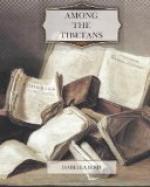The remaining marches to Leh, the capital of Lesser Tibet, were full of fascination and novelty. Everywhere the Tibetans were friendly and cordial. In each village I was invited to the headman’s house, and taken by him to visit the chief inhabitants; every traveller, lay and clerical, passed by with the cheerful salutation Tzu, asked me where I came from and whither I was going, wished me a good journey, admired Gyalpo, and when he scaled rock ladders and scrambled gamely through difficult torrents, cheered him like Englishmen, the general jollity and cordiality of manners contrasting cheerily with the chilling aloofness of Moslems.
The irredeemable ugliness of the Tibetans produced a deeper impression daily. It is grotesque, and is heightened, not modified, by their costume and ornament. They have high cheekbones, broad flat noses without visible bridges, small, dark, oblique eyes, with heavy lids and imperceptible eyebrows, wide mouths, full lips, thick, big, projecting ears, deformed by great hoops, straight black hair nearly as coarse as horsehair, and short, square, ungainly figures. The faces of the men are smooth. The women seldom exceed five feet in height, and a man is tall at five feet four.
The male costume is a long, loose, woollen coat with a girdle, trousers, under-garments, woollen leggings, and a cap with a turned-up point over each ear. The girdle is the depository of many things dear to a Tibetan—his purse, rude knife, heavy tinder-box, tobacco pouch, pipe, distaff, and sundry charms and amulets. In the capacious breast of his coat he carries wool for spinning—for he spins as he walks—balls of cold barley dough, and much besides. He wears his hair in a pigtail. The women wear short, big-sleeved jackets, shortish, full-plaited skirts, tight trousers a yard too long, the superfluous length forming folds




